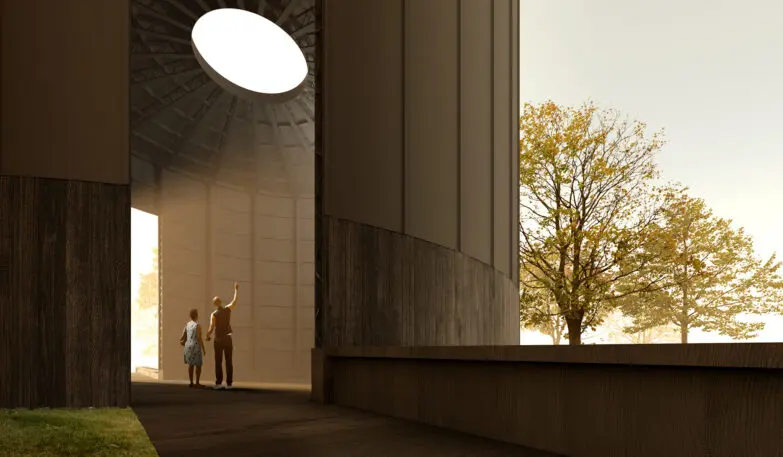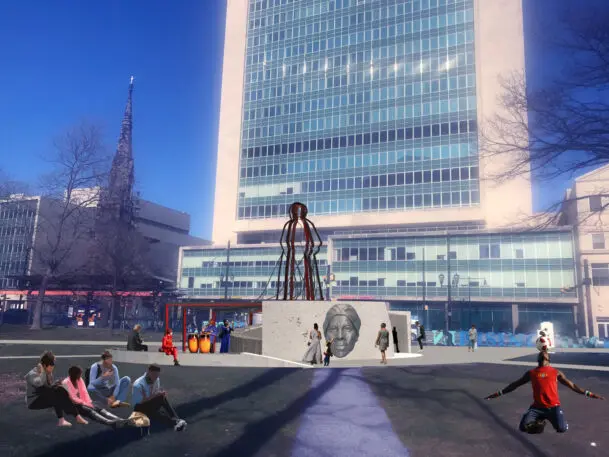Forced labor is the dark secret of the building industry. Many of the key materials used to construct buildings around the world are made by unfair and inhumane labor practices, including modern slavery and unpaid child labor.
A new effort is hoping to stop that, with a series of pilot projects that will try to show how it’s possible. One is a new library building. Another is the recently announced 2022 edition of the Serpentine Pavilion, a coveted architectural commission in London’s Hyde Park that will be designed this year by artist Theaster Gates.
These projects aspire to greatly reduce the risk that buildings are built with slave labor—which is a shockingly difficult goal to achieve, even today. In November 2020, an industry group called Design for Freedom issued a damning report showing that forced labor is an all too common part of the global supply chain of building materials. From steel beams made from ore mined in China to two-by-fours available in hardware stores across the U.S., the raw materials of everyday buildings are sometimes produced on the backs of an estimated 25 million people forced into unpaid labor and modern slavery around the world. It’s a problem so widespread, the group found, there’s no easy way to know whether a building is, in some way, built with slave labor.

The first project is a new facility for the New Canaan Library, a nonprofit in New Canaan, Connecticut. Construction on the building began in late 2021 and is expected to complete in early 2023. In collaboration with its architect Centerbrook, general contractor Turner Construction, and 21 subcontractors, the library will require that 30 different building materials be tracked as far down the supply chain as possible to ensure that no forced labor is involved in their production. Getting there will be a challenge.
Though not every material in every building is likely a product of slave labor, many of the basics could be. Timber, one of the most commonly used construction materials, is often logged illegally. According to Design For Freedom’s report, up to 50% of that illegal timber is produced through forced labor—a figure that can be as high as 80% in countries like Peru and Russia.
Saying a material is slavery-free will be a tricky standard to prove, especially when the pathways from forest to lumber yard or iron mine to steel manufacturer aren’t always clearly mapped. Part of Design For Freedom’s effort is to shed more light on these supply chains, and hopefully get contractors and their suppliers to take more responsibility for the labor behind their materials. The library project is seen as a first step in figuring out how to do that—and showing other projects how to follow suit.

But it is also just temporary, on display this year in London from June to October. In New Canaan, where the Grace Farms Foundation is located in its own architecturally significant building, designed by SANAA, the other pilot project is permanent, and could provide significant lessons on how the ideals of Design For Freedom meet the realities of urban development.
The New Canaan Library was already in the design phase already when Design For Freedom contacted officials there about being involved. Lisa Oldham, executive director of the New Canaan Library, says she jumped at the opportunity to be Design For Freedom’s first pilot project, while also recognizing the challenge it presented. “Honestly, I said yes and thought, ‘Oh gosh how are we going to make this happen?'” she says. “But I didn’t see no as an answer once I understood the scope and the scale of the problem.”
Each subcontractor on the project has committed to doing the research with their materials suppliers to get as clear a picture of their provenance as possible, and to try to ensure that forced labor has no part in their production. The materials being analyzed include mineral wool insulation, countertops, metal roof panels, wood doors, tile, flooring, lighting, vinyl, glass, steel, PVC piping and more.
Two other projects—a sculpture by the artist Alyson Shotz on the site of Grace Farms’ campus in New Canaan and a new memorial to Harriet Tubman in Newark—are also Design For Freedom pilots, exploring their own smaller supply chains.

For the New Canaan Library, finding answers has meant having contractors and the construction manager in near constant conversation with suppliers and each other about where materials are coming from and what can be known about how they’re produced. “We are pushing our suppliers to identify as far back into the supply chain as they can,” says Oldham. “If we uncover something, we are definitely looking to swap things out. But our focus is on helping to determine how do you do this.”
Prince says the pilot project’s main goal is to nail down the process. Once it becomes easier to source slavery-free materials, more buildings will be able to confidently declare that they have been made without them. Prince says bringing in so many industry partners, and involving so many subcontractors, is a way to accelerate that process. “I want to truncate the timeline that it takes to adopt the Design For Freedom principles,” she says. “We can’t wait 50 years like it’s taken the green building movement to be adopted and normalized. ”
Oldham says asking these questions is hard to frame in dollar figures; additional research costs are being borne by a third party. The cost, Oldham argues, is trivial compared to the goal of the Design For Freedom movement. “If there’s one child not being forced to slave in an iron mine in western China, then I think it’s worth it,” she says.
She also recognizes that there will be a learning curve. As the first project taking this approach, it won’t necessarily be easy to get the full story of every material in the building. Even so, she’s hoping some of the lessons from this process can be put on display in the new library, and documented for others to use in their own building projects.
“We’re not going to be able to say this is the first slave-free building, because we won’t be able to know that,” Oldham says. “The hope is that the work we’re doing on this project means that in time, whether it’s the next project or the fifth project, there will be the means that slavery in the built environment can be eradicated.”
Recognize your brand’s excellence by applying to this year’s Brands That Matter Awards before the early-rate deadline, May 3.
